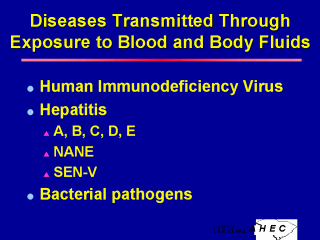| front |1 |2 |3 |4 |5 |6 |7 |8 |9 |10 |11 |12 |13 |14 |15 |16 |17 |18 |19 |20 |21 |22 |23 |24 |25 |26 |27 |28 |29 |30 |31 |32 |33 |34 |35 |review |
 |
Some infectious agents can be transmitted during the exchange of blood or body fluids through unsafe sex practices, needle sharing, accidental needle sticks, and blood transfusion. As many as 5.2 million people in the U.S. are infected with viral hepatitis. Five viruses (A, B, C, D, E) cause 80% to 90% of cases worldwide. The remaining 10% to 20% are of unknown origin or NANE (non-A/non-E) hepatitis. A newly identified virus, SEN-V is believed to account for 68% of all cases of chronic NANE hepatitis. It is estimated that 30% of HIV patients are infected with SEN-V. Blood transfusion is a less common source of exposure to these agents, thanks to improvements in donor screening, serologic testing, and transfusion practices that have made the US blood supply one of the safest in the world. However, blood is a human tissue, and is therefore a natural vehicle for transmission of infectious agents. During the 1980ís, HIV was transmitted through clotting factor and blood transfusions, and in the 1990ís Hepatitis C was transmitted via immunoglobin. In the late 1990s, Hepatitis C is an emerging infectious disease that affects an estimated 3.9 million persons in the US. A national campaign is underway to test, counsel and provide medical evaluation and treatment for those infected. Bacterial pathogens are also transmitted via blood. Since 1985, there have been 21 reported episodes of red blood cell transfusions contaminated with Yersinia enterocolitica leading to 12 deaths. USDHHS (1998), Preventing Emerging Infectious Diseases: A Strategy for the 21st Century, Atlanta: Centers for Disease Control and Prevention. USDHHS, Morbidity and Mortality Weekly Report, 47(RR-15), September 11, 1998, Atlanta: CDC. |
| front |1 |2 |3 |4 |5 |6 |7 |8 |9 |10 |11 |12 |13 |14 |15 |16 |17 |18 |19 |20 |21 |22 |23 |24 |25 |26 |27 |28 |29 |30 |31 |32 |33 |34 |35 |review |